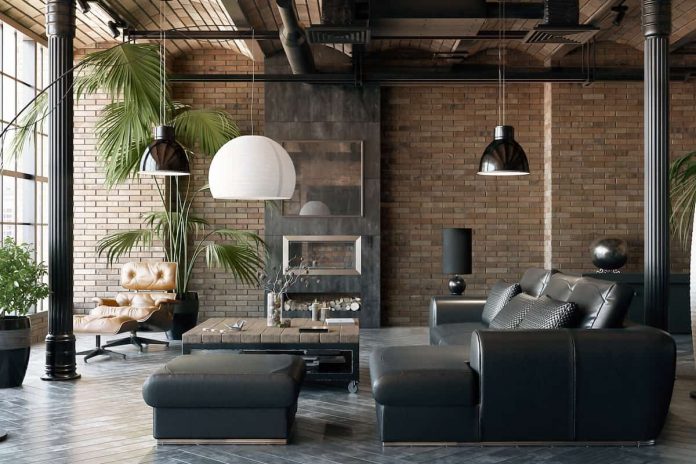The industrial style has become one of the great sources of inspiration in the world of decoration. A style with its own name that is here to stay on the podium of the great favorites of interior designers and lovers of interior design.
But what is industrial decoration? You will recognize it for its unmistakable unfinished air and its factory atmosphere, and it is characterized above all by its high ceilings, open spaces, exposed brick walls, exposed beams and furniture that masterfully combines wood and metal.
What is the origin of the industrial style?
To discover it, we propose a journey through space and time: today we will visit the city of New York at the end of the 19th century and the beginning of the 20th . It is the height of industrialization and many factories and warehouses are being built in lower Manhattan and will be operating at full capacity.
But, just a few decades later, the price of rents and land in this small New York Big Apple will skyrocket, forcing much of the industry to relocate to more affordable areas of the city and its surroundings, leaving these factories and empty warehouses.
In this New York of the 1950s and 1960s with an increasingly large population, the shortage of housing and its increasingly high prices pushed many inhabitants, especially artists, to look for an alternative to live in: these abandoned factory spaces.
Due to the initial purpose for which they were designed, they had extremely high and unadorned ceilings, large windows, open spaces and bare walls. Voila! The most representative elements of the industrial style.
8 characteristics of the industrial look in decoration
exposed brick walls
In order to save costs in the construction of the factories of the time, the walls were not embellished or plastered. That is why the brick walls were left in sight and just as the first inhabitants of these abandoned spaces left them, maintaining their idiosyncrasy and personality.
Today there are many options to create the same effect as exposed brick such as wallpaper , vinyl, murals or even decorative panels with relief that achieve a very realistic finish.
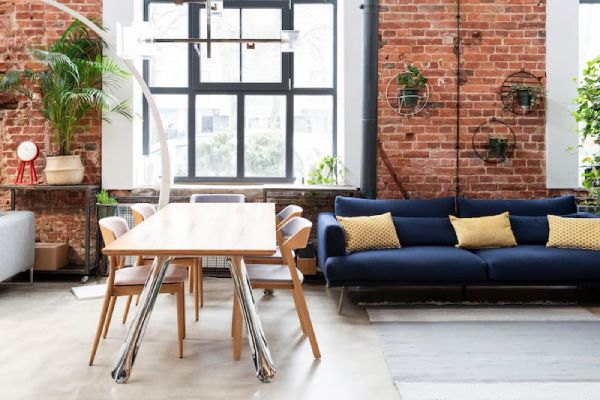
High ceilings
The large machinery and the need for storage space in the old factories that gave rise to the first homes with an industrial look made it necessary to have a great height. Today it is not always possible to have this vertical space at home, but did you know that you can make your ceilings appear higher?
This visual effect is achieved by painting or covering the walls in darker tones and reserving a much lighter tone for the ceiling, the whiter the better.
Diaphanous spaces
It is one of the great contributions of the industrial style to the world of decoration and not only to those environments designed under its inspiration, but it is also applicable to different decorative styles. Eliminating walls and partitions is one of the most common and demanded reforms , since it generates greater spatial fluidity, visually expands the space and increases the useful surface.
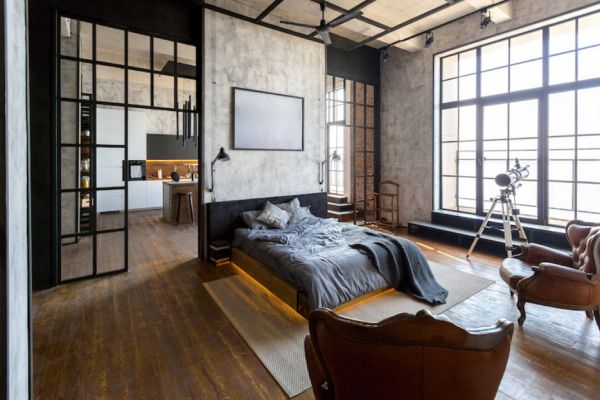
exposed beams
The voluminous iron beams of the factories are another of the most characteristic elements of the industrial style. Thus, the ceilings become great protagonists. If you want to incorporate them into the decoration of your home, there are ornamental beams with an imitation iron or steel finish that perfectly reproduce their visual effect and are very easy to install.
Ducts and pipes, also visible
Ventilation ducts and unhidden pipes with a false ceiling are another of the great legacies of the original loft look , which is reproduced in contemporary spaces in a very aesthetic way, even creating the extraction hoods of industrial-style kitchens. .
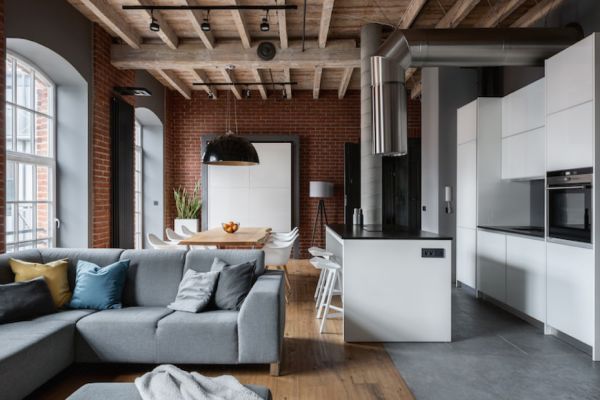
industrial style lighting
Large pendant lamps with voluminous black metal shades are the protagonists, along with Edison-type filament bulbs that today are used even without a shade in industrial-inspired decoration, making them shine on their own.
parts icon
Some of the most iconic contemporary design furniture is currently associated with the industrial style, such as the Tolix metal chairs or the Chester sofas of English origin , especially in a brown leather finish, which provide the most elegant and sophisticated note with their unmistakable quilted upholstery: a true “ Englishman ” in New York.
Furniture and recovered materials
Recycling and upcycling are also characteristic of this decorative style. In the 50s and 60s, when the factories began to be inhabited, many elements that had been abandoned were used.
In this way, for example, metal transport carts and lockers become industrial-style sideboards or improvised cabinets, and pallets are transformed into coffee tables, fitted with large metal wheels.
The personality that impregnated these first converted pieces of furniture made them so coveted that there are now many decoration firms that manufacture completely new lines of furniture inspired by these pieces.
The materials that mark the DNA of the industrial style
The manufacturing origin of the industrial style explains the reason for the robustness and coldness of the most characteristic materials:
- Brick : as we have seen, brick walls without plaster are one of the most recognizable and representative elements of this decorative style.
- Concrete : it was common to find it on the ground and also on the walls of factories and warehouses. Today, although it is still used in spaces inspired by the industrial style, there are alternatives such as microcement and paints, even textured, that imitate its rough finish.
- Iron : it is one of the most common metals in this type of decorative style: both in profiles (windows and large windows) and in beams, furniture and lamps.
- Steel : An alternative to iron that is increasingly used in contemporary industrial-inspired spaces.
- Wood : adds a warm touch to a cold loft – like environment . The counterpoint to metal and concrete. The great favourite: reclaimed wood in thick planks, showing the traces of the passage of time. The beauty is precisely in its imperfection.
- Leather and skin: on sofas, armchairs, backs and seats of chairs and stools and even on rugs. The nobility of the leather also creates a stylish contrast with the austerity of the rest of the elements of the industrial style. Today many decorators opt for softer fabrics such as linen or cotton to create loft-inspired environments, but more serene and relaxed.
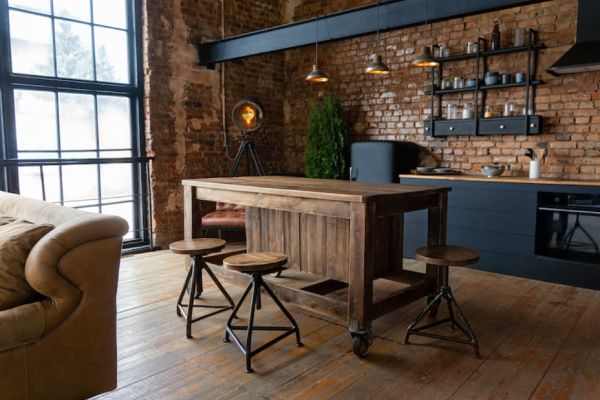
The color range: three (or four) is enough
The most genuine industrial style colors are rather scarce: black, gray and brown , which correspond to the tones of the most characteristic materials. To add luminosity, white is always the most successful tone, since being neutral it illuminates without altering the chromatic personality of this style.
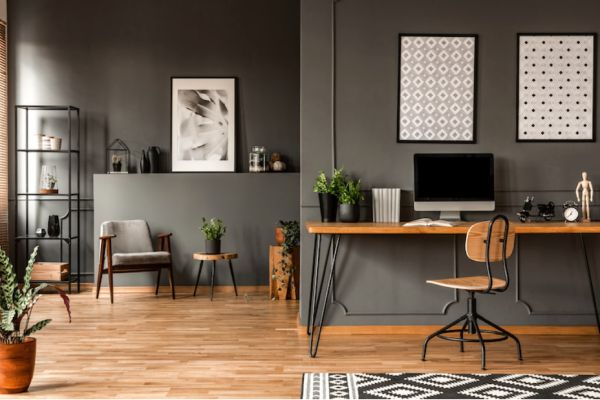
How to achieve an industrial style without being too cold?
One of the great virtues of decoration, and the team of interior designers knows it well , is the possibility of combining elements of different decorative styles to create more personal homes that are much more welcoming. To soften the hardness and visual coldness of the industrial look, the key is to combine the characteristic materials of this style with others that are much warmer and more serene .
Parquet floors instead of concrete or polished cement, fabric upholstery such as cotton or linen instead of leather and leather, giving more presence to the color white to offset dark tones such as black and brown, as well as choosing inspired furniture Nordic , for example, with its characteristic light wood and its curved or rounded shapes.
If you want to see how the industrial style would look in your home before tackling a renovation project or looking for much more inspiration and ideas for this look, we recommend the best decoration apps .
